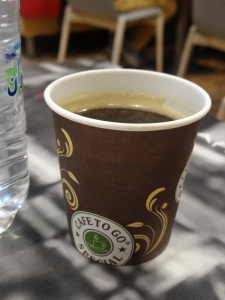
My food landscape has drastically changed. I have been back in the UK for 3 weeks and there are still things of the reverse food-culture-shock that grab my attention. OK, ‘shock’ is an over-dramatic word, but re-encountering food in the UK offers plenty to chew on. So the blog will continue into my brave post-fieldwork research world.
Both my mind and body are adjusting to the return from North Africa. I had become used to the feeling of being full from bread, and now even things like a stir-fry and rice seem to be lacking a broken round loaf spread about the table. Drinking water from the tap is still a luxury. I have a slight sense of doing something borderline wrong when drinking alcohol, like getting into a pub when you are still under-age, you’re fine, but secretly hope that a friend of your parents doesn’t walk in and catch you.
The biggest change though is that I’m not researching alone anymore. I am still alone on my PhD project because let’s face it that’s the nature of the beast, but I’m surrounded by others and their counterpart theses. Back in the office theories are being considered, data is being crunched, chapters compiled. It might not have the scents of mint tea and the spices of tagine, but this new research environment is by no means food-free.
We have snacks. At 10.55am there is a rustle of foil. There is the crunch of a crisp. We have lunch. At 1pm there is the twinkling of packets, catching the light in the common room as these little features of lunchtime in the UK formulate the third element of the corporate balance of a ‘meal deal’. We have drinks. At 5pm one is torn open, splayed across the table and shared in the pub. At the weekend I had friends over for dinner. Three of the big special packets arrive with the guests. The ones that you buy for other people, as a treat, to share, to mark your contribution to the feast and which bear the hallmarks of taste.
So I noticed crisps. Are they a reflection of our country on the run, no time for the kitchen, in love with corporate promises? Or are they bought as part of our desire to share ideas? We buy a packet in the pub, tear it open and invite everyone to keep their thoughts going with a few calories and some salt, the salt encouraging the flowing of more drinks and more thoughts. I’m really not sure, so I thought I’d call on the advantages of being back in the office and working in company. Who better to contribute to a post-fieldwork exploration of crisps than someone else just back from fieldwork?
My fellow PhD friend Ed who was nice enough to let me interview him on the abnormal topic of ‘crisps and fieldwork’ admitted to being a crisp fan. His favourite brand: Monster Munch. He’d been back for just four weeks, and so the details of his experience were still fresh. He went to Brazil, he enjoyed it. There was “samba on every street corner and the beer was cold”. What did he eat? I was curious. “Meat, rice and beans. Buffet food sold by weight” he hasn’t found anywhere here yet where food is sold by weight. “Crisps?” I asked? “Did you eat any crisps while you were on fieldwork?” “Yes”, he said. He told me they were in big bags with flavours like “Churrasco”, “Pacanha”, the usual suspect brands, but with adaptions to their flavours to suit the particularities of the Brazilian market. The same was true in Morocco, big bags with local flavours, sold on trains and at service stations. They didn’t make it much into Thursday though. So did Ed find crisps in the same places in Brazil as he does in the UK? “No”. The big bag wasn’t gutted in the pub by many hands all at once. Instead the beer was shared directly, one big bottle and lots of glasses. Crisps reduced to their rightful status, junk food; “comfort food”.
I’d point out here that I quite like crisps, there is something slightly exciting about buying a bag of cut up potato slices. A bag containing a whole potato wouldn’t quite be the same. You could try sprinkling it with some culturally appropriate flavours, but there is something about the work being done for you, the cutting, cooking and packaging, that seems to fit in well in the UK. I wonder how long the excitement will last. I asked Ed if he’d be going back to Brazil. He told me, “Yes, I’m sure I will, but I’m not sure when”. I agree.



 Coffee to go. I went. But I didn’t go without passing through the tourist Morocco that allowed me go to get here in the first place. I bought the presents, had the breakfast on the terrace, and in the airport I had a… coffee.
Coffee to go. I went. But I didn’t go without passing through the tourist Morocco that allowed me go to get here in the first place. I bought the presents, had the breakfast on the terrace, and in the airport I had a… coffee. 







